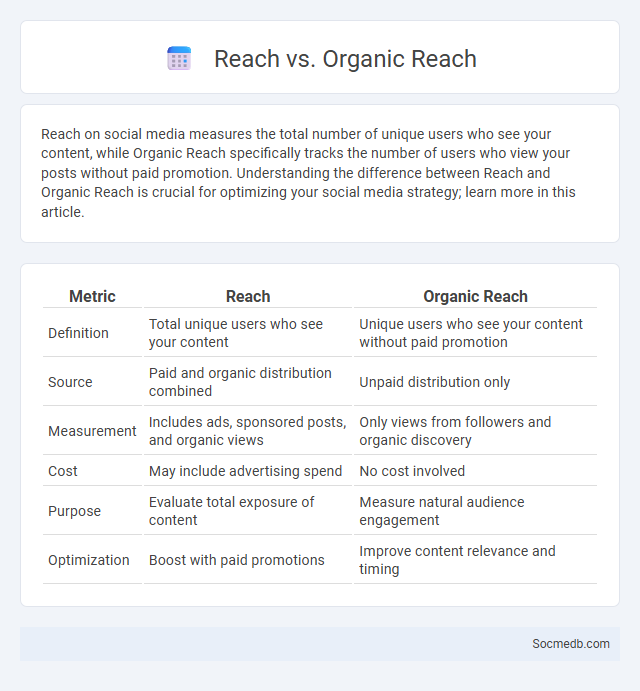
Photo illustration: Reach vs Organic Reach
Reach on social media measures the total number of unique users who see your content, while Organic Reach specifically tracks the number of users who view your posts without paid promotion. Understanding the difference between Reach and Organic Reach is crucial for optimizing your social media strategy; learn more in this article.
Table of Comparison
| Metric | Reach | Organic Reach |
|---|---|---|
| Definition | Total unique users who see your content | Unique users who see your content without paid promotion |
| Source | Paid and organic distribution combined | Unpaid distribution only |
| Measurement | Includes ads, sponsored posts, and organic views | Only views from followers and organic discovery |
| Cost | May include advertising spend | No cost involved |
| Purpose | Evaluate total exposure of content | Measure natural audience engagement |
| Optimization | Boost with paid promotions | Improve content relevance and timing |
Understanding the Concept of Reach
Reach on social media measures the total number of unique users who have seen a specific post or content. It plays a crucial role in assessing the effectiveness of marketing campaigns and helps businesses gauge brand awareness and audience engagement. Tracking reach enables targeted strategies to optimize content visibility across platforms like Facebook, Instagram, and Twitter.
What Is Organic Reach?
Organic reach refers to the number of unique users who see your social media content without paid promotion. It primarily depends on the platform's algorithm, user engagement, and content relevance. Understanding organic reach helps you optimize your social media strategy to increase visibility and connect authentically with your audience.
Differences Between Reach and Organic Reach
Reach refers to the total number of unique users who have seen your social media content, encompassing both paid and unpaid views, while organic reach specifically counts only those users who encounter your posts without any paid promotion. Understanding the difference between reach and organic reach helps you evaluate the effectiveness of your content strategy and determine how much of your audience engagement comes naturally versus through advertising spend. You can optimize your social media efforts by analyzing organic reach metrics to improve content relevance and increase genuine user interaction.
How Reach Is Measured on Social Platforms
Reach on social media platforms is measured by the total number of unique users who have seen a specific post or advertisement. This metric is tracked through platform analytics tools such as Facebook Insights, Instagram Analytics, and Twitter Analytics, which use algorithms to count distinct viewers rather than total impressions. Accurate reach measurement helps marketers understand audience size and optimize content strategies for higher engagement and brand visibility.
Factors Affecting Organic Reach
Organic reach on social media heavily depends on engagement metrics such as likes, comments, and shares, which signal content relevance to algorithms. Content quality and consistency influence user interaction rates, thus impacting visibility. Platform-specific algorithm updates and posting times also play crucial roles in determining how widely posts are distributed without paid promotion.
The Impact of Algorithms on Reach
Algorithms on social media platforms determine the visibility and reach of your content by prioritizing posts based on user engagement, relevance, and behavior patterns. These algorithms analyze data such as likes, comments, shares, and viewing time to decide which content appears in users' feeds, significantly affecting organic reach. Understanding and adapting to these algorithmic changes can help you maximize your social media presence and audience engagement.
Strategies to Improve Organic Reach
Leveraging high-quality, engaging content tailored to target audiences significantly boosts organic reach on social media platforms. Consistent use of relevant hashtags and timing posts during peak user activity periods enhances visibility and interaction rates. Engaging with followers through comments and interactive features like polls fosters community growth and strengthens algorithmic favorability.
Paid Reach vs Organic Reach
Paid reach on social media refers to the number of users who see content as a result of paid promotions or advertisements, enabling precise targeting based on demographics, interests, and behaviors. Organic reach, on the other hand, represents the visibility of posts shared naturally without payment, relying heavily on algorithms and user engagement to distribute content. Brands leverage paid reach to accelerate visibility and reach specific audiences quickly, while organic reach builds authentic engagement and long-term community growth.
Importance of Tracking Both Reach Types
Tracking both organic and paid reach on social media platforms is crucial for understanding overall audience engagement and campaign effectiveness. Organic reach provides insights into genuine user interest and brand loyalty, while paid reach offers data on targeted audience response and advertisement ROI. Combining these metrics enables businesses to optimize content strategies for maximum visibility and impact.
Key Takeaways on Reach and Organic Reach
Social media organic reach has declined significantly, with platforms like Facebook experiencing drops to under 5% for average posts. Maximizing organic reach involves creating highly engaging, shareable content tailored to target audiences and optimizing post timing based on user activity insights. Leveraging platform-specific features such as Stories, Reels, and live videos can boost visibility without relying on paid advertising.
 socmedb.com
socmedb.com